Meeting of the Board of Regents | June 2008
|
|
THE STATE EDUCATION DEPARTMENT / THE UNIVERSITY OF THE STATE OF NEW YORK / ALBANY, NY 12234 |
|
TO: |
Higher Education Committee |
|
FROM: |
Johanna Duncan-Poitier
|
|
SUBJECT: |
P-16 Implementation: Improvements in Teacher Certification Processing and the Effects on the Supply of Qualified Teachers
|
|
DATE: |
June 4, 2008 |
|
STRATEGIC GOAL: |
Goal 3 |
|
AUTHORIZATION(S): |
|
SUMMARY
Issue for Discussion
How has implementation of the TEACH system affected the issuance of teaching certificates and the supply of qualified and certified teachers?
Reasons for Consideration
Review of Policy.
Proposed Handling
At the June 2008 meeting, information will be presented to the Committee on the impact of the TEACH web-based certification system to date.
Procedural History
At the March 2007 Higher Education Committee meeting, the Regents viewed a demonstration of TEACH, the Web-based certification system, then less than one year old. This discussion will provide a summary of TEACH implementation in its second year. The focus is on the degree of success in meeting the intended goals of providing faster, more efficient handling of certification applications and other services to applicants, teachers, and schools.
Background Information
P-16 Action Plan
The Regents, through the P-16 Action Plan, have called for strengthening instruction from a systems perspective, focusing on teacher quality, an equitable distribution of highly qualified teachers, professional development, teacher retention, and integration of technology. TEACH is moving to its promise of expedited, efficient processing of applications for certification. It also has provided the Office of Teaching Initiatives (OTI) with the ability, for the first time, to track and document aspects of the services it provides. This report presents some of this data, which is proving critical in refining processes, redeploying staff to meet changing needs, and managing workload.
The implementation of TEACH has been a real partnership between OTI staff, from their work on the original design and testing of the system to current maintenance and recommended enhancements and Information Technology Services (ITS) staff, in both fixing problems and adding enhancements to the system.
Work Process Improvements
The ability of applicants to submit a certificate application online is a major efficiency made possible by TEACH, significantly reducing staff time spent in processing applications. Previously, staff had to enter data from paper applications into a database in order to create an individual’s file and to ready the application for evaluation and processing. TEACH has dramatically changed this picture. Online applications now account for over 96 percent of applications received. Chart 1 illustrates the switch from paper to online applications.
Chart 1
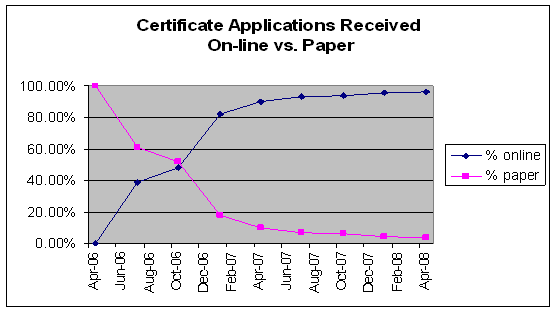
In addition to making applications immediately available for review and processing, the online application has allowed for the reallocation of staff for other duties. Former data entry clerks served in a one-year traineeship and now hold reclassified positions as licensing services clerks. These staff members now review and process the less complex applications, such as applications for Teaching Assistant Level I certificates, certificate progression applications, and the straightforward time extension applications. This enables the certification specialists to devote their time to the more complex evaluations and speeds processing significantly.
The efficiencies afforded by TEACH have helped reduce the backlog of applications. Chart 2 offers a comparison of the total certificates issued for the past three years. By 2007-2008, TEACH was fully functional and enabled the issuance of about 20,000 more certificates than in either of the previous two years.
Chart 2
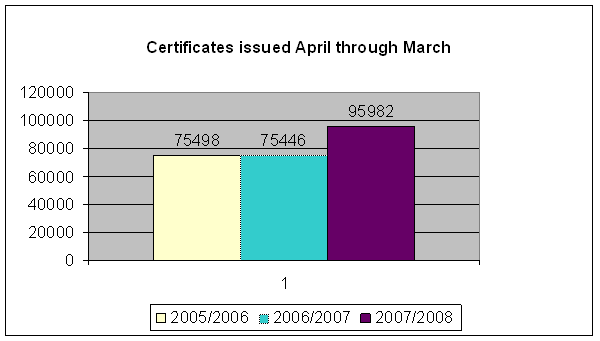
Most applications submitted through the college-recommended pathway now result in automatic issuance of certificates. Colleges are able to recommend graduates of their certificate programs online. If a graduate has applied and paid online and met all other requirements (such as testing and fingerprint clearance), the certificate is issued automatically within one day of recommendation. Chart 3 shows that, in 2007-2008, a large number of certificates were issued in the same quarter as spring graduation (April-June). By comparison, in 2006-2007 a larger number of certificates were not issued for spring graduates until the following quarter (July-August).
Chart 3
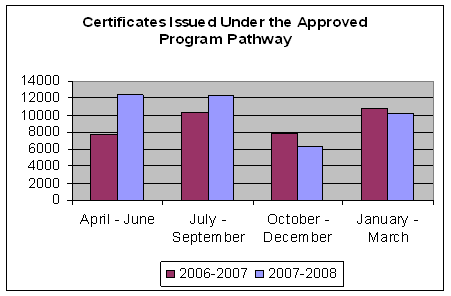
Individual Evaluation/Transcript Evaluation Pathway
In 2003, the Board of Regents adopted the current requirements for certification through the individual evaluation of credentials (commonly referred to as transcript evaluation) available to candidates seeking Initial certification in classroom teaching titles. Unlike the college recommended pathway, in which a candidate completes a full teacher preparation program and, upon completion of the program, the college recommends to the Department the candidate for certification, the individual evaluation pathway involves candidates submitting evidence of coursework and field experience to the State Education Department for evaluation. Once the candidate has met all the requirements for a teaching certificate, the certificate is issued.
The provision regarding individual evaluation included a sunset date for individual evaluation of February 1, 2007 for certificates in childhood education and February 1, 2009 for all other certificates in the classroom teaching service. The purpose in establishing these sunset dates was to allow the Department time to assess the continued need for the individual evaluation pathway, based on how many candidates use this pathway to become certified, particularly in subject areas where there are teacher shortages. The individual evaluation pathway ended for candidates seeking certificates in childhood education in February 2007 because there was no evidence of shortages in this subject area. However, because of the high reliance on the individual evaluation pathway to meet the demand for teachers in New York State in other certification areas, (in 2006-07, 11 percent of the teaching certificates issued were issued through individual evaluation), in February 2008, the Board of Regents endorsed the continuation of this pathway for at least the next three years.
Because applications submitted through individual evaluation require separate reviews of transcripts and course descriptions, these application reviews involve the most time. Efficiencies afforded by TEACH have resulted in a significant reduction in the time between when an application is ready for review and when reviewed by an evaluator, but there is still a backlog for the review and issuing of certificates through this pathway. Chart 4 shows that the lag time has been reduced from 20 weeks to 8 weeks over the past year.
Chart 4 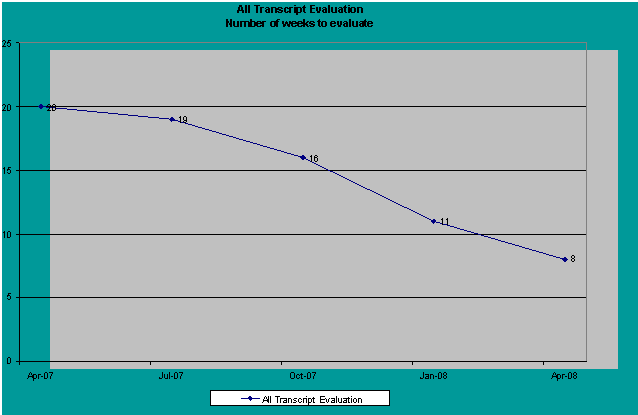
In addition, OTI has an “expedited service” procedure so that any school district that is seeking to employ a teacher whose certification application is pending with OTI can have that application processed in a timely manner and the teacher can be employed.
New Services for Applicants and Certificate Holders
TEACH has also allowed OTI to offer new services to applicants and certified teachers. By establishing an individual online TEACH account, applicants are able to view the status of their applications and track the posting of their exam scores, fingerprint clearance and other requirements as each is added to their records. This instant access reduces the need for applicants to call or e-mail OTI for this information. Applicants’ access to their own accounts has served to reduce the number of phone calls needed for simple status checks. In fact, there has been an approximate 43 percent reduction in the overall number of calls to the Teacher Certification main line over the past year.
Once certified, teachers can access additional services through their individual TEACH accounts. For example:
- Subsequent applications for additional certificates are simplified, because TEACH automatically credits the applicant with any requirements already met.
- Holders of Professional level and Teaching Assistant Level III certificates are able to access their professional development records to check that clock hour credits required for maintenance of their certificates are accurate and up-to-date.
- Teachers (and applicants) can automatically update their personal profiles to register address, phone and e-mail address changes.
School District
Services
Similarly, TEACH offers school districts services that provide faster access to information. Particularly important is the ability of districts to access information quickly when hiring. They can:
- Check the status of an individual’s application for certificate (“Issued”, “Ready for Review”, etc.).
- Submit fingerprint clearance requests.
- Check for an applicant’s fingerprint clearance.
OTI’s “expedited service” procedure provides any school district that is seeking to employ a teacher whose certification application is pending with OTI to have that application processed in a timely manner so that the teacher can be employed.
F
uture Enhancements
The Office of Teaching Initiatives continues to review and make recommendations for enhancements to TEACH through the use of Process Improvement Teams. The next major enhancement to TEACH is the introduction of digital LIVESCAN technology for fingerprint processing, expected to be in use by approximately 20 BOCES and school districts by the end of the summer.
Fingerprint supported criminal background checks are required both for certification and for employment in schools. LIVESCAN technology allows fingerprint images to be captured digitally and transmitted instantly to OTI using the Internet. The entire fingerprint process can be managed electronically with results available to covered schools in a few days.
The Office of School Personnel Review and Accountability (OSPRA) has been able to reduce the overall time-frame for processing fingerprints from approximately 3 months to 3-5 days. OSPRA will now be able to re-dedicate resources to begin processing fingerprints from private and non-public schools.
Challenges Remaining
Despite the many process enhancements and improvements that have been made over the last several years in OTI, challenges remain. Multiple changes in certification regulations and requirements and level staffing have meant that the Department’s capacity, even with major system advancements, is still limited.
As mentioned earlier, reviews of applications submitted through the individual evaluation pathway can be time consuming and often involve review of multiple transcripts and review of individual course descriptions from multiple institutions. Despite efficiencies gained through the TEACH system, these reviews can still take an average of 8 weeks which delays the issuance of certificates to qualified applicants.
The Department’s capacity to respond to the large volume of phone calls we receive (745,000 last year), though improved because of information available to applicants and others through TEACH, is still not sufficient.
OTI also receives a large volume of email inquiries, primarily from applicants for certificates. Many of these emails are a spill over from persons who were not successful in reaching our office by phone. The majority of inquiries, in order of volume, are: application status checks, requests for course approvals, inquiries from out-of-state applicants regarding reciprocity, and requests to change the application pathway previously selected. There is an approximate backlog of one week in responding to emails, although it varies throughout the year. Chart 5 shows the total volume by quarter for the past two years.
Chart 5
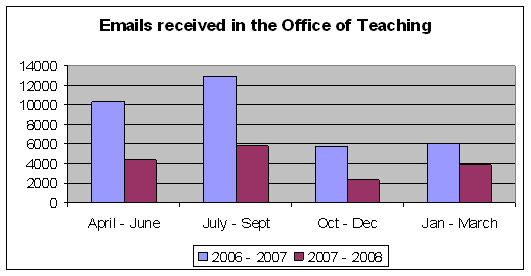
Conclusion
The TEACH system has provided the Department with an important tool to better serve individuals applying for teacher certification in New York State. As we continue to enhance the TEACH system, we expect that there will be further reductions in the backlog for certification through the individual evaluation pathway. We further anticipate that a reduction in the backlog will result in fewer phone calls and emails, allowing OTI staff to better serve the needs of all individuals seeking information on teacher certification in New York State. We will continue to work to improve the teacher certification system to better serve school districts and the teachers of New York State.
Recommendation
It is recommended that the Board of Regents and the Department continue to review and recommend improvements and enhancements to TEACH as an important tool in serving teaching applicants, practicing teachers, and schools.





